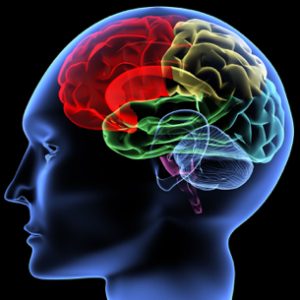About the Human Brain
The human brain is a complex organ that functions to support all human thought and coordinates all human actions and emotions. Despite the critical role of the brain in mediating all human behaviors, the average adult brain weighs only three pounds.
The human brain has three main parts:
- The cerebral cortex, divided into a left and right hemisphere, fills up most of your skull.
- The cerebellum sits at the back of your head, under the cerebral cortex. The cerebellum controls coordination and balance.
- The brain stem sits beneath your cerebral cortex in front of your cerebellum. It connects the brain to the spinal cord and controls automatic functions such as breathing, digestion, heart rate, and blood pressure.

Lateral (side) view of the human brain. The left cerebral hemisphere is depicted. The cerebral hemisphere is made up of different regions call ‘lobes’ including the frontal lobe (red), parietal lobe (yellow), temporal love (green) and the occipital lobe (blue). The cerebellum is shown in gray and the brainstem is shown in purple.
The brain contains about 100 billion nerve cells. These nerve cells have about 100 trillion connections (synapses) that form networks. This “strength in numbers” provides the raw material for the brain to function. Nerve cells communicate via electrical impulses, and can be influenced by dozens of different neurotransmitters or brain chemicals. Clusters or groups of nerve cells located in one brain region are connected to other clusters of neurons. Over time, our experiences create patterns in signal type and strength of these brain connections or networks. These patterns of activity explain how, at the cellular level, our brains code our thoughts, memories, motor skills, and a sense of who we are.
